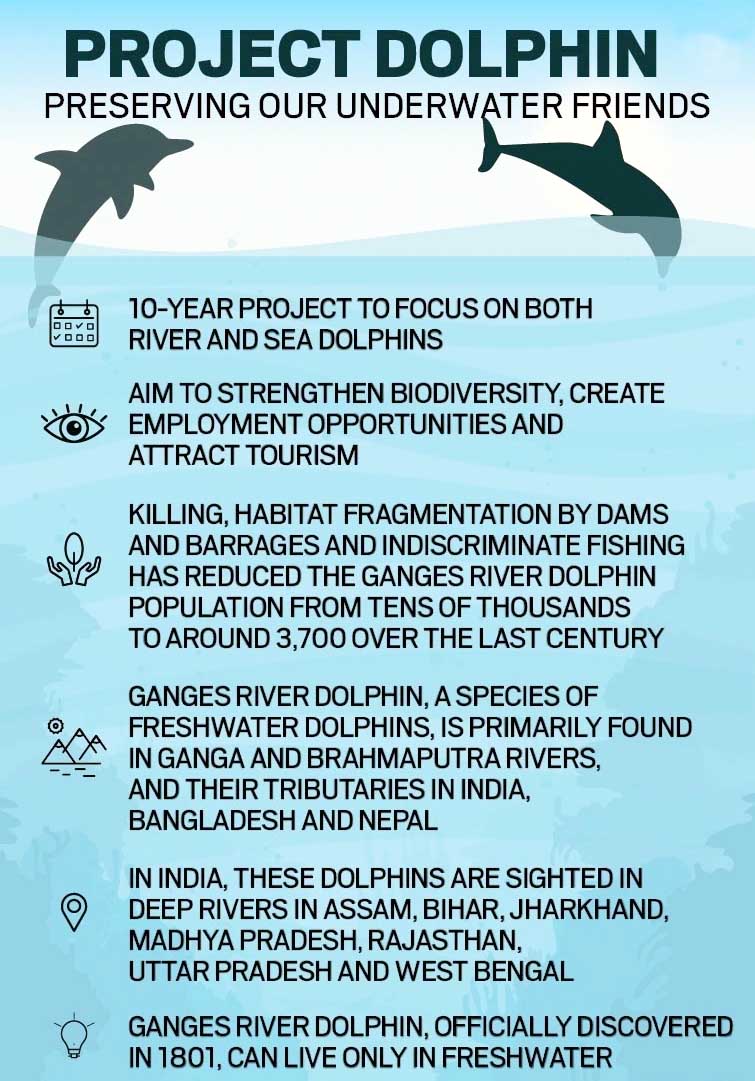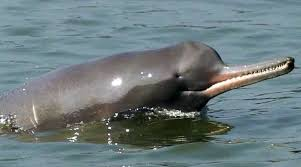Biodiversity & Environment
Project Dolphin
- 05 Sep 2020
- 5 min read
Why in News
The Prime Minister announced the government’s plan to launch a Project Dolphin in his recent Independence Day Speech (15th August 2020).
- The proposed project is aimed at saving both river and marine dolphins.
Key Points
- Project Dolphin will be on the lines of Project Tiger, which has helped increase the tiger population.
- Project got in-principle approval in December 2019, at the first meeting of the National Ganga Council (NGC), headed by the Prime Minister.
- It is expected to be implemented by the Ministry of Environment, Forest and Climate Change.
- Special Conservation program needs to be taken up for Gangetic Dolphin which is a national aquatic animal and also indicator species for the river Ganga spread over several states. As the Gangetic dolphin is at the top of the food chain, protecting the species and its habitat will ensure conservation of aquatic lives of the river.
- So far, the National Mission for Clean Ganga (NMCG), which implements the government’s flagship scheme Namami Gange, has been taking some initiatives for saving dolphins.
- Global Experience: The Rhine Action Plan (1987) of the International Commission for the Protection of the Rhine (ICPR) — representing Switzerland, France, Germany, Luxemburg and the Netherlands — helped in conservation of the salmon fish (also an indicator species).
Gangetic Dolphin
- Scientific Name: Platanista gangetica
- Features:
- These are generally blind and catch their prey in a unique manner. They emit an ultrasonic sound which reaches the prey.
- These are also called susu.
- Location:
- It is found mainly in the Indian subcontinent, particularly in Ganga-Brahmaputra-Meghna and Karnaphuli-Sangu river systems.
- It is also found in the Ganga’s tributaries.
- Threats:
- Dams disturb the migration, breeding cycles and habitat of fish and other prey.
- Pollution.
- Excessive silting and sand mining especially in Assam and lower course of the Ganga.
- Population:
- The Gangetic dolphin census suggests that the Gangetic dolphin population in India could be about 2,500-3,000.
- As per Ministry of State for Environment, Forest and Climate Change there are about 1,272 dolphins in Uttar Pradesh and 962 in Assam.
- Status of Conservation:
- In the First Schedule of the Indian Wildlife (Protection), Act 1972.
- Endangered by the International Union for the Conservation of Nature (IUCN).
- Appendix I (most endangered) of the Convention on International Trade in Endangered Species (CITES).
- Appendix II (migratory species that need conservation and management or would significantly benefit from international co-operation) of the Convention on Migratory Species (CMS).
- Conservation Efforts:
- Wildlife Protection Act: In 1986 after the launch of Ganga Action Plan in 1985, the government included Gangetic dolphins in the First Schedule of the Indian Wildlife (Protection) Act 1972.
- It means they have the highest degree of protection against hunting.
- This was aimed at checking hunting and providing conservation facilities such as wildlife sanctuaries.
- For instance, Vikramshila Ganges Dolphin Sanctuary was established in Bihar under this Act.
- Conservation Plan: The Conservation Action Plan for the Ganges River Dolphin 2010-2020, which “identified threats to Gangetic Dolphins and impact of river traffic, irrigation canals and depletion of prey-base on Dolphins populations”.
- The National Ganga River Basin Authority (replaced by National Ganga Council) in 2009 and constituted a Working Group under the Patna University to prepare a Conservation Action Plan for the Gangetic Dolphin in 2009.
- National Aquatic Animal: In 2009, during the 1st meeting of the National Ganga River Basin Authority, the Gangetic river dolphin was declared as the national aquatic animal.
- The National Mission for Clean Ganga celebrates 5th October as National Ganga River Dolphin Day.
- Wildlife Protection Act: In 1986 after the launch of Ganga Action Plan in 1985, the government included Gangetic dolphins in the First Schedule of the Indian Wildlife (Protection) Act 1972.






